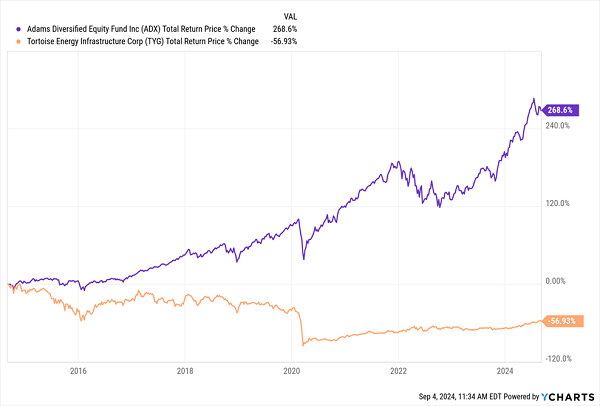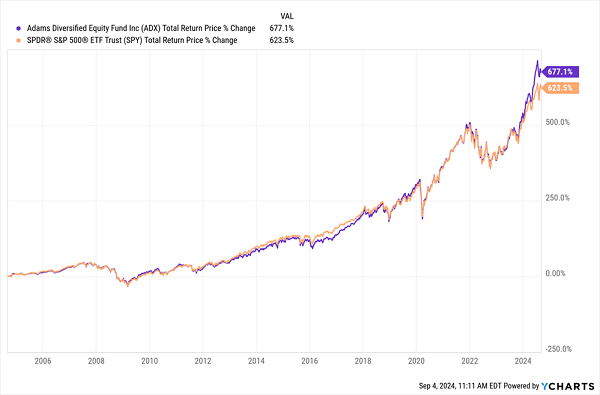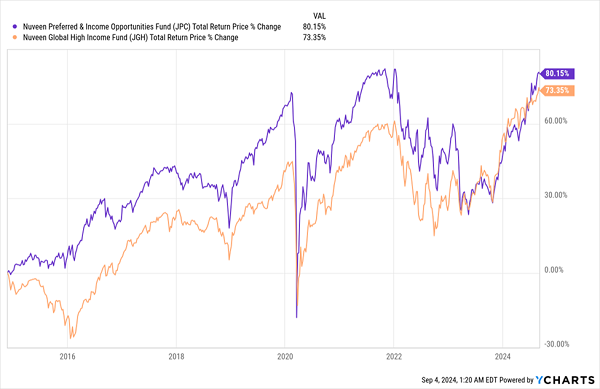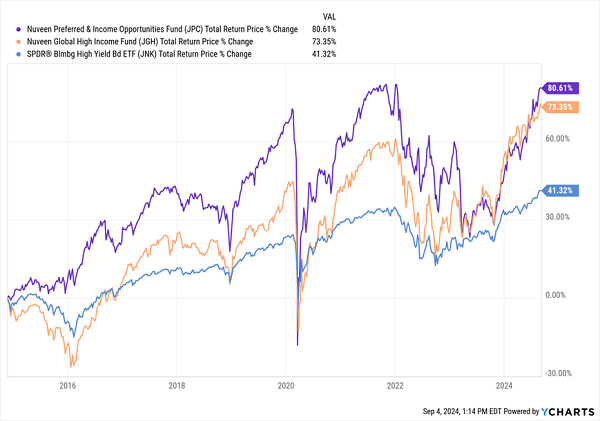When it comes to investing, there are two critical “bedrocks” we need to keep in mind. Everything else builds out from there.
They are:
- Diversification cuts your risk of loss. The more diversification, the lower your risk.
- In the long term, stocks and bonds make money, regardless of short-term volatility.
These two facts are why 95% of my favorite high-income investments, closed-end funds (CEFs), have made investors money over the last decade. Those include the 8.4%-yielding Adams Diversified Equity Fund (ADX).
ADX’s portfolio of large cap stocks includes Microsoft (MSFT), Visa (V), JPMorgan Chase & Co. (JPM) and Eli Lilly & Co. (LLY). Stock picks like these have helped ADX post a stellar 296% total return, on a market-price basis, in the last decade.
As for the 5% of CEFs that lost money?
They tend to be undiversified funds with a focus on the volatile energy sector, like the Tortoise Energy Infrastructure Corp (TYG), shown in orange in the chart below. TYG’s lack of diversification beyond midstream energy companies is why its fate has been very different from that of ADX (in purple).
A Tale of Two Funds

This is why we tend to avoid energy funds in my CEF Insider service: We’re looking for longer-term holds that give us high, steady (and often monthly) dividends. Energy, while profitable in shorter stretches, is tough to fit into our long-run focus.
With that in mind, when it comes to buying CEFs for the long term, a diversified fund is usually the better way to go. But we do need to talk about one other thing here: size. It’s a key piece of the CEF story because CEFs tend to be smaller than their popular ETF cousins. As a result, they tend to be overlooked—and a great place to go hunting for bargains.
Frankly, it’s too bad most people miss out on CEFs, because not only have 95% of them made money in the last decade, but there are plenty that beat comparable ETFs. Consider ADX’s best ETF benchmark, the S&P 500-tracking SPDR S&P 500 ETF Trust (SPY), a common holding in many portfolios.
ADX (in purple below) has clearly outrun it in the last decade. And due to the massive difference in these funds’ yields (1.2% for SPY, around 8.4% for ADX), much of ADX’s return in that time was in dividend cash:
ADX Beats the Market, With Most of Its Return in Cash

Even so, many people miss out on ADX because of the popularity of SPY and the fact that the ETF is much larger: SPY has $551 billion in assets, 190 times more than ADX!
Keep Size in Perspective When Buying High-Yield Closed-End Funds
If you think it’s unfair to compare a CEF and an ETF on the basis of size, I get it. So let’s look at another pair of CEFs: the Nuveen Preferred & Income Opportunities Fund (JPC) and the Nuveen Global High Income Fund (JGH).
Both yield around 10% now, and both are managed by the same team. But JGH (in orange below) is smaller than JPC (in purple), with $300 million in assets compared to the bigger fund’s $2.5 billion. Regardless, both have performed well in the last decade:
Different-Sized Bond CEFs Offer Similar Returns

We see here that both funds have similar returns—up until a few weeks ago they were exactly the same—though the smaller JGH has lagged for much of this timeframe. More recently, volatility has encouraged more investors to buy JPC.
Even so, these two seem to be tracking each other as higher interest rates have increased bonds’ appeal. That also means investors who bought these funds in 2023 have done well:
Buying When the Market is Selling

But right now, the smaller JGH, with its 5.7% discount to net asset value (NAV), compared to 3.4% for JPC, and slight underperformance, has particular appeal, given that it has the same management and has shown its tendency to catch up to the larger fund. This is why we tend to focus on CEFs between $200 million and $1 billion in market cap at CEF Insider—it’s where the best values are.
Here are some other factors to consider when picking amongst these high-yield funds.
Our CEF “North Stars”: Management, Portfolio, Value
The great thing about JPC and JGH is that they’re managed by bond experts who know the market inside and out. Nuveen has over a trillion dollars in assets under management, so it knows a lot about which companies are thriving, which are struggling, and how all of that plays out in today’s economy.
As a result, both funds (in purple and orange below) have crushed the SPDR Bloomberg High Yield Bond ETF (JNK), in blue, the index fund tracking corporate bonds.
Human Managers Give JGH and JPC an Edge

In fact, almost every corporate-bond CEF beats the corporate-bond index while offering much bigger yields.
With yields around 10% for both JPC and JGH, these funds are twice as generous as JNK, yet they attract significantly less investor money. That makes no sense considering their superior returns over the long term.
So what’s causing big ETFs to attract more money than the better-performing alternatives? The secret is in the name: the “C” in “CEF” stands for closed, meaning these funds cannot issue new shares to new investors and get bigger.
ETFs can. So even if a CEF is doing well, it can’t issue new shares to new investors, so the only way to get in is to buy shares from another investor. Fortunately CEFs are publicly traded, so they’re readily available to retail investors looking for superior returns and higher yields.
“But if CEFs are so great,” you might be asking, “why don’t more people invest in them?”
Honestly, I don’t have a good answer for that. But I can tell you the small minority of people who do invest in them have used them to obtain financial independence. I left my academic career in my 30s thanks to CEFs and started writing on them for fun. I’m still having fun writing about them today.
You can join these contented investors in CEFs, which yield around 8% on average and, as we just saw, regularly outperform ETFs. I’m mystified as to why, in light of this, anyone would choose ETFs, despite them being a very popular choice.
A Reliable 5-CEF Portfolio That Crushes Index Funds, Yields 8.7%
These 2 bond CEFs clearly show why we prefer CEFs to any other asset class or strategy: They give us most of our return in dividend cash, thanks to their high yields.
AND as I said, many CEFs beat their indexes, too, making them the clear choice over ETFs—the low-yielding “cool kids” of the investment world.
Still, if you’re new to CEFs and are still a bit hesitant, I get it. It’s always hard to take the plunge on something new. Which is why I want to make it as easy as possible for you to try out CEFs yourself.
To that end, I’ve put together a “mini-portfolio” of 5 CEFs that kick out a reliable 8.7% payout. Here’s what your income stream could be if you bought now:
- $200,000 invested generates $17,400 a year.
- $500,000 invested generates $43,500 a year.
- $1 million invested delivers $87,000 a year.
And on it goes!
I can’t wait to share the details on this 5-fund portfolio with you. Click here and I’ll tell you more, including more on why CEFs are off most investors’ radar. I’ll also give you the opportunity to download a FREE Special Report revealing the names and tickers of these 5 wonderful CEFs.

Recent Comments